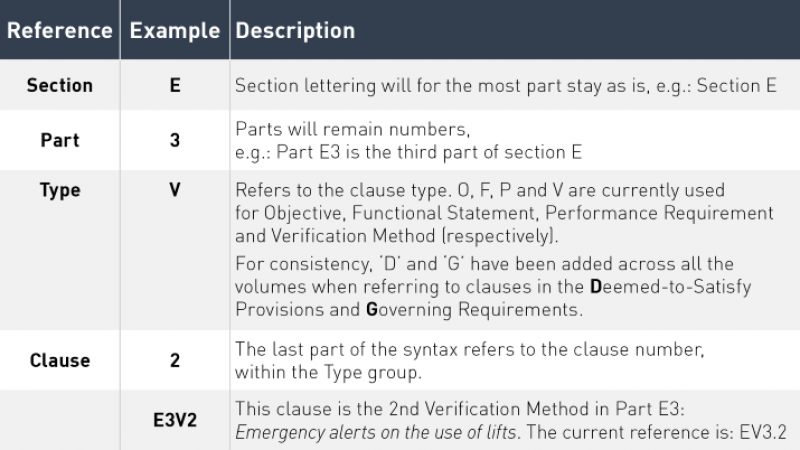The ABCB is committed to delivering an NCC that is user-friendly and modern, through a range of initiatives. This initiative forms part the Board’s long-term strategy to provide a more user-friendly online NCC that is better understood by a broad base of practitioners, with the next round of enhancements coming in NCC 2022.
These enhancements focus on digitisation of the code and improving its readability (more details below). But because the code has evolved over many decades and was originally designed as a print publication, changes to its structure and format are required. This is to ensure the NCC operates in a consistent and predictable way, within and across its volumes, without changing the intent of the code in any way.
A uniform structure and format will mean the NCC:
- Is more easily digested and understood by users, encouraging greater adoption across industry.
- Is machine-readable which means it can be converted into a range of digital formats, allowing features such as personalised filtering of content.
- Encourages digital innovation such as integration with commonly used industry software and systems.
- Allows for contemporary education and training opportunities, incentivising new entrants to the building and plumbing industries.
These changes have been designed with NCC users in mind. And although they won’t be implemented until the 2022 edition, practitioners can expect to see the new layout in the NCC 2022 Public Comment Draft in May 2021.
Resources
To achieve a well-organised, logical and easily digestible code that is better placed to support all NCC users, four key areas have been improved for NCC 2022. These are addressed in detail below, but are the result of the ABCB’s overall vision for change shown in the Roadmap to better building and plumbing outcomes infographic.
To support practitioners through the changes, the ABCB has developed a range of resources that explain why and how the code is changing, and what it means in practice. They are available below for viewing and downloading, but if you have a question or concern please contact us.
General
- Overall vision infographic - Roadmap to better building and plumbing outcomes
- What to expect for Public Comment Draft (PCD) infographic - A new look for the NCC 2022 PCD
- Video - A new look for NCC 2022 webinar and Q&A recording
- FAQs - A new look for NCC 2022 webinar FAQs
Consistent volume structure
NCC 2022 has a new Information Architecture, which allows for a Consistent Volume Structure (CVS) across the entire code.
SPTC referencing system
The improved clause referencing system, Section-Part-Type-Clause (SPTC), has been developed to create a consistent referencing (numbering) system across all volumes, while retaining key aspects of the current system where possible.

Clause structure
A simple reorganising of the code’s content will mean a consistent clause structure across all volumes, and within volumes, greatly improving comprehension of the code and enhancing the user-friendliness.
Web content accessibility
Improvements have been made to the visual display of content within the code, making it easier to read and reference, as well as allowing for greater understanding of its intent.
- Access the web content accessibility supporting document
- Access the web content accessibility Connect article
So while NCC 2022 may look a bit different at first, the features and benefits will go long way in better supporting NCC users in achieving compliance.
The ABCB also has plans in place to transition practitioners over to the new structure as smoothly as possible, such as providing both (old and new) clause referencing systems in NCC 2022 for ease of reference.
Our useability strategy
The overall strategy to improve useability of the NCC has four main components: readability, digitisation, education and product development. There are intersecting implications for each project element.
Digitisation
In embracing calls from the building and plumbing industries for digitisation of the code, the changes to the code’s structure and format enable machine-readability, which opens the door to a range of new and refreshed digital formats.
This allows for:
- Greater ease of integration of NCC content with third party vendors, including BIM software.
- Customised digital outputs to be generated for use on mobiles, tablets, desktops, etc.
- Multiple formats including PDF, responsive HTML, progressive web apps and eBook versions being able to be generated on-demand.
- A personalisation layer which will let users refine the NCC content based on criteria specific to their industry, area of expertise and ultimately the building/plumbing project they’re currently working on.
Readability
The availability of free online access to the NCC in 2015 brought with it a much larger and broader cross-section of practitioners, and other users, accessing the NCC. To account for this, a more user-friendly NCC that is accessible to a broader audience is vital to ensuring the code is easily understood and referenced, leading to greater compliance across industry.
The NCC readability initiative involves the re-packaging of the NCC to simplify its use and, therefore, make it more accessible to the wider audience that have been exposed to the NCC as a result of it being made available free online. The initiative relates to NCC language and NCC format. Major changes were implemented in NCC 2019 for Volume Three, and the NCC Governing Requirements and Schedules. The focus from NCC 2022 onwards will be on improving the readability of NCC Volumes One and Two.
Product development
The ABCB will continue to identify and develop a new range of supporting products and materials to assist in the understanding and awareness of the NCC.
This will include:
- practitioner materials for download and online viewing
- education materials for practitioners, students, educators and trainers, and
- information videos, webcasts and presentations.
These products and materials are designed for all levels of knowledge and experience within the building, construction and plumbing industries.
The ABCB welcomes feedback on existing products and materials and along with suggestions from stakeholders on new opportunities to increase useability and understanding of the NCC.